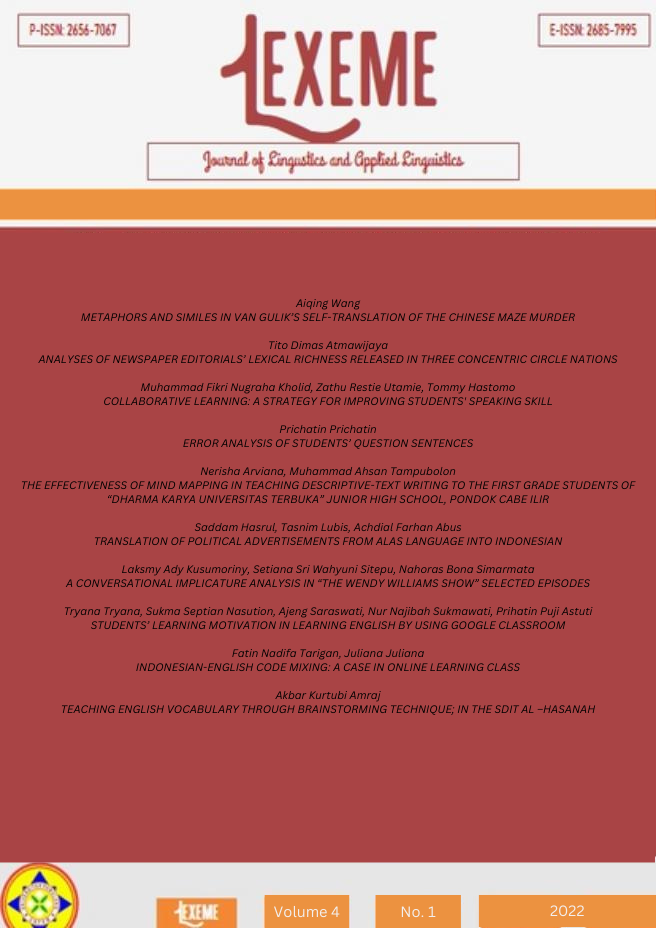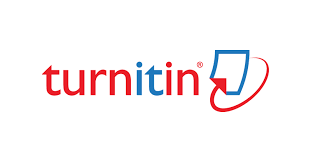INDONESIAN-ENGLISH CODE MIXING: A CASE IN ONLINE LEARNING CLASS
DOI:
https://doi.org/10.32493/ljlal.v4i1.19526Keywords:
code mixing, online learning, Indonesian, EnglishAbstract
English educators in all levels of education in Indonesia nowadays strive through to make their college students master in speaking and writing English. One of the ways to succeed the students are by asking them use English or Indonesian-English code-mixing in their classroom include in online learning class. This study aims at finding out the types of Indonesian-English code mixing in online learning class. A descriptive qualitative method was used to perform this study. The data for this study employed the students’ chats in Google Meet and Whatsapp as platforms of online class. The subjects were English Education Department students of Universitas Pembinaan Masyarakat Indonesia in three online class. The instrument utilized was documentation. This study was conducted entirely online. Therefore, the data were collected by screenshots of the chat then were categorized as code mixing and the types of code mixing. Content analysis was applied for analyzing the data. The findings indicates that most of students used code mixing with types of word insertion with 52.4 % continued by phrase insertion. The lowest percentage was types of idiom insertion with 2.5%. Hence, the lecturer know what should be improved for the students. It is necessary to get used to the students to use English idiom in order to improve their language skill.
References
Arikunto, S. (2013). Prosedur Penelitian Suatu Pendekatan Praktik. Jakarta: Rineka Cipta.
Davistasya, R. E. (2019). Code-Mixing In Language Style Of South Jakarta Community Indonesia. Premise: Journal of English Education and Applied Linguistics, 8(2), 193-213.
Grosjean, F. (1982). Life with two languages. Cambridge, MA: Cambridge University Press.
Helmie, J., Halimah, H., & Hasanah, A. (2020). Code mixing in college students’ presentation: a case in an intercultural communication class. Indonesian Journal of EFL and Linguistics, 5(2), 403-417.
Hoffman, C. (1991). An Introduction to Bilingualism. New York: Longman.
Horasan, S. (2014). Code-switching in EFL classrooms and the perceptions of the students and teachers. Journal of Language and Linguistic Studies, 10(1), 31-45.
Li, W. (2000). Dimensions of bilingualism. In W. Li (Ed.), The bilingualism reader (pp. 1-25). London: Routledge.
Mershad, K., & Wakim, P. (2018). A Learning Management System Enhanced with Internet of Things Applications. Journal of Education and Learning, 7(3), 23. https://doi.org/10.5539/jel.v7n3p23
Narasuman, S., Wali, A. Z., & Sadry, Z. (2019). The functions of code-switching in EFL classrooms. Social and Management Research Journal (SMRJ), 16(2), 137-152.
Purwanto, E., & Tannady, H. (2020). The Factors Affecting Intention to Use Google Meet Amid Online Meeting Platforms Competition in Indonesia. Technology Reports of Kansai University, 62(06), 2829–2838.
Ran, W., & Jinglu, L. (2020). The Design and Development of Digital Books for E-learning. 2020 4th International Conference on Artificial Intelligence and Virtual Reality, 51–55. https://doi.org/10.1145/3439133.3439140.
Sardar, S. S., Ali Mahdi, A. A., & Subakir Mohd, Y. M. (2015). Code-switching in daily conversations among Iraqi students in Malaysia. Arab World English Journal (AWEJ) Vol, 6.
Shartiely, N. E. (2016). Code-switching in university classroom interaction: A case study of the University of Dar es Salaam. Stellenbosch Papers in Linguistics Plus, 49(1), 215-231.
Siskawati, (2012). Code Mixing Found in C’est La vie Novel. A Thesis. Semarang: Diponegoro University.
St John, A. (2020). It’s not just Zoom. Google Meet, Microsoft Teams, and Webex have privacy issues too. Consumer Reports, 3.
Sutrismi, S., Wijayanto, A., & Laila, M. (2014). The use of Indonesian English code mixing in social media networking (Facebook) by Indonesian youngsters (Doctoral dissertation, Universitas Muhammadiyah Surakarta).
Suwito. (1983). Sosiolinguistik. Surakarta: Fakultas Sastra Universitas Sebelas Maret.
Wardhaugh, R., & Fuller, J. M. (2021). An introduction to sociolinguistics. John Wiley & Sons.
Yip, V. (2013). Simultaneous language acquisition. In F. Grosjean & P. Li (Eds.), The psycholinguistics of bilingualism (pp. 119-36). Hoboken: Wiley-Blackwell.







